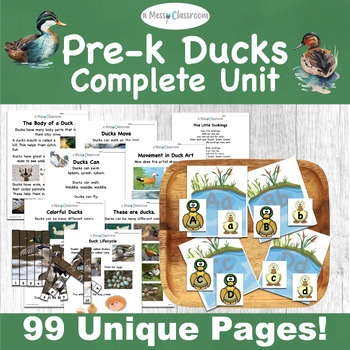Preschool Duck Unit of Study Counting Colors Lifecycle Anatomy Art Movement Song
- PDF
Description
This Preschool Duck Unit of Study covers so many learning goals for kindergarten and preschool students! They will practice counting, colors, the lifecycle of a duck, the anatomy of a duck, art, physical activities with movement, and poetry and songs.
TELL ME MORE
Begin by studying all about duck anatomy. There is a lesson plan. The text, "The Body of Duck," is simple and easy to read with real photographs. There is a paper duck puzzle where students can practice with the duck anatomy in a hands-on way. There is a cut and paste activity with the duck body parts. Four vocabulary words are included with vocabulary cards. The words are palmate feet, bill, feathers, and wings. Students will also practice with the words tail and eyes. The poster asks students to look at a real photograph of a duck. There is a simple math count the feathers worksheet and a duck coloring page where students are instructed to color the duck body parts certain colors.
Ducks sure do have a unique way of moving! Ducks are also amazing creatures in that they are at home in the air, on the land, and in the water. There is a second lesson plan about duck movement. The text, "Ducks Move," is a simple read for kids and included words like waddle, flap and splash. The vocabulary words are waddle, swim, fly, and quack. There is also a short text about bobbing in the water. Students can practice the difference between ducks and geese while playing a game and then counting the duck and the goose. There is a coloring sheet about palmate feet, a review from the previous lesson since ducks use their feet to move. There is a verb coloring page where students color the words waddle, flap, quack, and splash. The math worksheet asks students to count the ducks swimming, waddling, and flying respectively. There is a poem which can also be a song called "Ducks Can." This encourages students to do the duck movements themselves. Finally, students will look at how movement is shown in art, specifically studying how ducks are shown moving with different art styles.
It's time to practice our colors! Though the little yellow ducklings often come to ming when thinking of these fun birds, there are many different duck colors. There is a lesson plan all about duck colors. The poster introduces the word rainbow. The vocabulary words and cards in this lesson are rainbow, colorful, different, and violet. The color words are red, orange, yellow, green, blue, purple, violet, grey, white, and brown. There are three coloring papers to go along with this lesson. There is also a pattern practice paper. The text for this lesson is a bit longer than the others with many different colorful ducks shown. There are captions under each photograph so students can learn the names of those ducks if you would like. Math includes colorful duck counters and ponds with numbers, students should put the correct number of ducks in the pond.
Let's practice with out letters! Focus on the letter D with two letter D worksheets. There are two duck alphabet activities. The first has adult ducks with the capital letters, baby ducklings with the lowercase letters, and ponds with both. Students should place the ducks in the correct ponds. The second has all of the letters on colorful ducks. Students can practice making different words from the unit.
Interject more math into the duck study with some math and logic puzzles. There is a printable song, "Five Little Ducklings." There is also shadow matching papers. The draw the duck activity will help students with hand-eye coordination. There is a duck puzzle that you can cut out and have students put the numbers in order to complete the picture. There are two additional coloring pages. The duckling counters are super cute and can help students to complete the duckling number worksheets. There are also two duck counting worksheets where students can practice with the singular and plural forms of the words while counting the duckling and ducklings.
And a unit on ducks wouldn't be complete without a duckling lifecycle lesson. The text, "Duck Lifecycle," includes real photographs. There are three diagram posters included. The eight vocabulary words included drake, hen, duckling, hatch, embryo, nest, duck, and hatchling. There are also large posters of these words. The coloring and tracing sheet can be used for early finishers or as a simple end to the unit.
I hope you and your littles enjoy learning all about ducks!
WHAT'S INSIDE
- 3 Lesson Plans
- 8 Short Texts Including Poems, Songs and Nonfiction
- 5 Posters
- 40 Small Vocabulary Cards [20 words, 20 Definitions with Pictures]
- 8 Large Vocabulary Pages
- 3 Cutting and Sorting Activities
- 2 Puzzles
- 9 Math Pages
- 5 Pattern and Shadow Matching Papers
- 10 Coloring Pages
- And Much More
WANT MORE?
Buy these Mermaid Colors Bundle
Check out this Pre-K Bird Unit!
If you enjoy this product please leave a review! Consider following me HERE.





